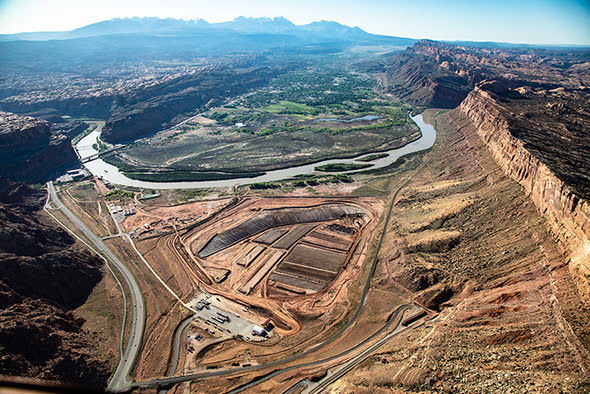Some information may be outdated.
The Moab Uranium Mill Tailings Remedial Action (UMTRA) site is testing out a new method for cleaning up contaminated groundwater underneath the old uranium mill, which is right next to the Colorado River.
For years, UMTRA workers have been pumping contaminated water out of the aquifer to prevent it from reaching the river. This spring, the UMTRA site partnered with scientists from the Lawrence Berkeley National Laboratory to try something new.
Instead of pumping out of the aquifer, they’ve developed a way to trap the contaminated groundwater so it doesn’t leak into the river. In March, researchers started injecting the aquifer with a mineral called apatite, which acts like a sponge to absorb the uranium in the water.
“We’re not removing the uranium from the environment, ” said Kenneth Williams, a senior scientist at the Lawrence Berkeley National Laboratory. “We’re removing the uranium from part of the environment where it’s mobile and can cause problems — dissolved in groundwater, slowly making its way to the Colorado River.”
Uranium occurs naturally in groundwater, especially around Moab where there are high concentrations of the element. The point of the experiment isn’t to take uranium out of the aquifer, but rather to slow down how quickly that uranium flows into the river.
“The analog would be to take a sponge that you’ve soaked with black ink and throw it into a swimming pool,” said Williams. “You’re going to be slowly bleeding that black ink off the sponge into the rest of that pool water. Same thing applies for these former uranium sites.”
The idea is that the apatite will stay in the aquifer and sequester the uranium so it’s no longer dissolved in the water. The experiment started in March, and Williams says the first results were successful.
“We’re seeing a reduction in uranium concentration by a hundredfold,” he said. “We’re getting decreases in uranium concentration from 2000 parts per billion to a level that, at least in mid-April, are now down to 20 parts per billion.”
“To put that in context, the drinking water standard that the U.S. Environmental Protection Agency sets for uranium is roughly 30 parts per billion,” said Williams. “Over the course of these three short injection experiments, we have lowered uranium concentrations below the drinking water standard set by the EPA.”
They don’t have any plans as of right now to remove the uranium-apatite mixture from the aquifers. But William says that could be a possibility in the future.
“Over a fixed amount of time, you could propose going in with a backhoe and digging that…uranium out of the ground and hauling it to the [disposal center] in the same way that the tailings from the Moab site are being hauled up to…Crescent Junction.”
Williams is looking forward to seeing whether the experiment holds up this spring with potential floods near the UMTRA site.
“What a unique year we have in terms of high snowpack and high runoff,” he said. “The Moab site itself is already partially flooded, but that’s just how nature works. When you have a really dynamic environment in terms of river water and groundwater systems, how is the barrier going to perform under that really dynamic process?”
The Lawrence Berkeley National Laboratory and the UMTRA project are both funded by the U.S. Department of Energy.
This story aired previously on KZMU News, and is republished here as part of a collaboration between KZMU & the Moab Sun News.
This story has been edited for clarity.
Appreciate the coverage? Help keep local news alive.
Chip in to support the Moab Sun News.





